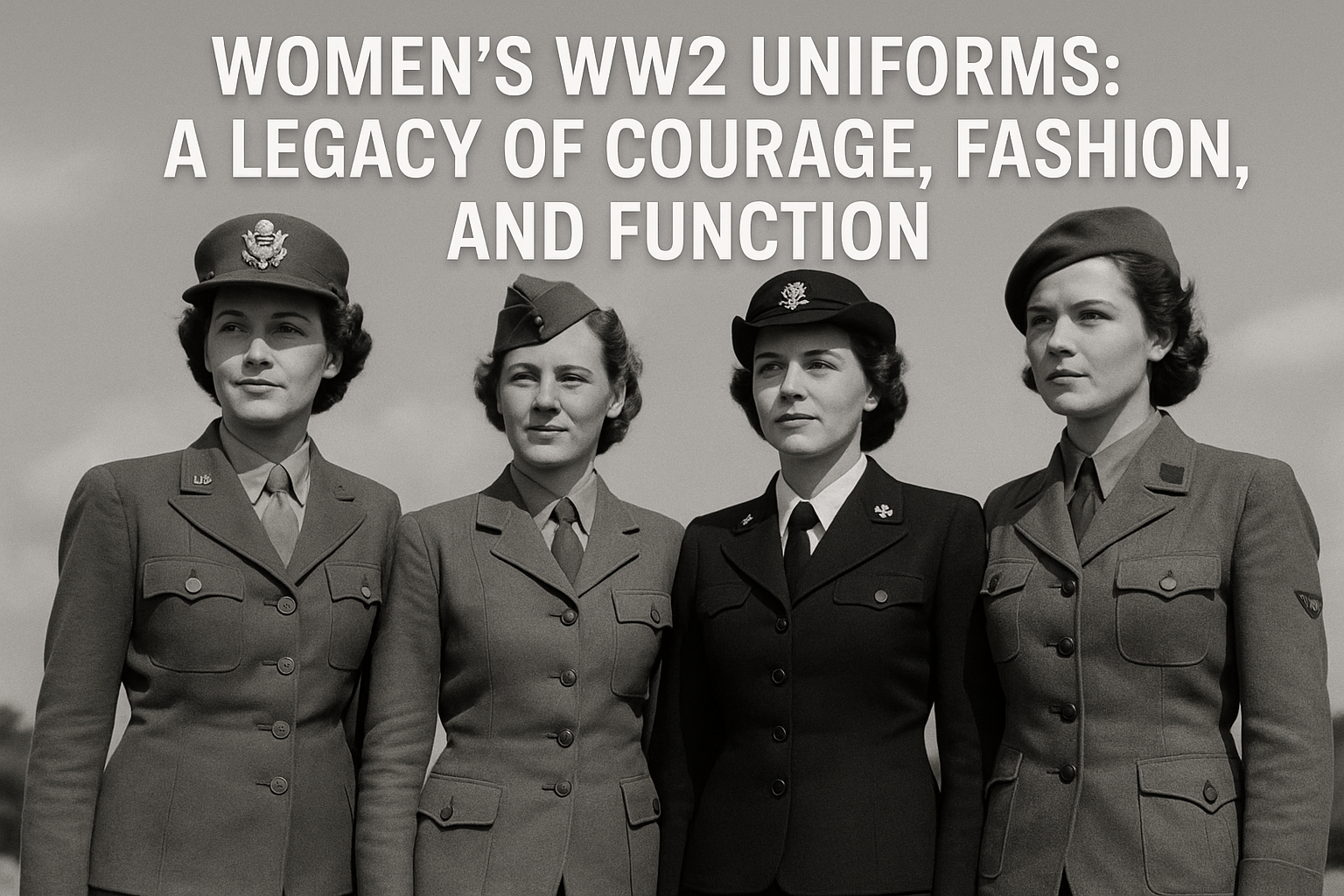
Women's WW2 Uniforms: A Legacy of Courage, Fashion, and Function
Published on Jun 26, 2025
Women's WW2 Uniforms: A Legacy of Courage, Fashion, and Function
During World War II, women stepped into roles that redefined their societal position—and their attire reflected this shift. Women's WW2 uniforms were more than just standard military clothing; they represented a pivotal moment in history when women became visible contributors to the war effort. At Paddelaters, we honor this legacy by offering historically accurate WW2 women’s uniforms for collectors, reenactors, and history lovers.
In this article, we’ll explore:
- The history and evolution of women's uniforms during WW2
- Key military branches and their uniforms
- Differences between Allied and Axis female uniforms
- Common accessories and insignias
- Where to buy or view authentic and replica uniforms today
1. The Rise of Women's Military Roles in WW2
Before WW2, women’s participation in the armed forces was minimal. However, as the war escalated and men were deployed to the frontlines, millions of women joined auxiliary services across Allied nations.
Key Roles Women Played:
- Nurses and Medics
- Clerical and Administrative Staff
- Factory and Munitions Workers
- Pilots (e.g., Women Airforce Service Pilots - WASP in the U.S.)
- Intelligence and Communication Operators
As roles diversified, so did the need for standard uniforms, which led to the creation of practical, durable, and rank-specific women's WW2 uniforms.
2. Notable Women's WW2 Uniforms by Country
United Kingdom: ATS, WAAF, WRNS
- ATS (Auxiliary Territorial Service): The largest British women’s military branch, responsible for signals, clerical work, and more. The ATS uniform was typically a khaki jacket, tie, and skirt.
- WAAF (Women’s Auxiliary Air Force): Known for their blue-gray tunics and skirts, WAAF personnel supported RAF operations.
- WRNS (Women’s Royal Naval Service): Distinguished by navy blue uniforms with white blouses and black ties.
United States: WAC, WAVES, WASP
- WAC (Women’s Army Corps): Wore olive drab skirts and matching jackets. Their design mirrored men’s service uniforms but adjusted for comfort and practicality.
- WAVES (Women Accepted for Volunteer Emergency Service): U.S. Navy female division with dark navy blue jackets, white shirts, and black ties.
- WASP (Women Airforce Service Pilots): For airfield work, uniforms were typically khaki trousers, flight jackets, and coveralls.
Germany: Helferinnen (Female Auxiliaries)
- German female auxiliaries wore functional grey or field-blue uniforms, often with minimal decoration. They worked in communications, administration, and anti-aircraft roles.
3. Uniform Components and Accessories
Authentic women’s WW2 uniforms weren’t just about the base clothing. They included:
- Caps and Berets: Each service had its distinctive headwear
- Insignia and Rank Badges: Crucial for identifying roles and hierarchy
- Utility Belts and Pouches: Carried tools, radios, or medical kits
- Footwear: Usually leather ankle boots or service shoes
- Outerwear: Greatcoats and capes for cold-weather conditions
Fabric and Fit:
Most uniforms used wool or cotton blends for durability. The fit was tailored yet practical, designed to allow freedom of movement while maintaining a clean, official look.
4. How Uniforms Represented a Shift in Gender Roles
Uniforms were a visible marker of changing societal norms. Women in uniform represented patriotism, bravery, and competence. Hollywood and wartime propaganda even glamorized them, with actresses donning tailored military styles that blended femininity with authority.
Today, these uniforms are sought after for historical education and their place in the evolution of women’s fashion and societal roles.
5. Collecting and Reenacting: The Modern Appreciation
Why Collect WW2 Women’s Uniforms?
- Historical Value: Each piece tells a story
- Reenactments: Living history events rely on accuracy
- Museum Exhibits: Help preserve the visual record of women in war
- Vintage Fashion: 1940s silhouettes are still admired today
At Paddelaters, we provide:
- Authentic WW2 reproductions
- Custom sizing for reenactors
- Complete sets with accessories
- Detailed research for accuracy
6. Buying Guide: Where to Find Quality Women’s WW2 Uniforms
When shopping for women’s WW2 uniforms, consider:
- Authenticity: Are materials and designs historically accurate?
- Condition: For vintage, inspect wear and tear
- Source: Trustworthy websites like Paddelaters.com offer curated collections
- Purpose: Collecting, wearing, or displaying?
Our site offers options for British, American, and German women’s uniforms, each with full documentation and sizing support.
7. Caring for Vintage or Replica Uniforms
Proper care ensures your uniforms last decades:
- Storage: Use breathable garment bags
- Cleaning: Avoid machine washing vintage items; dry clean when necessary
- Repair: Patch and reinforce weak areas using period-correct materials
Conclusion: Celebrating the Women Who Served
Women's WW2 uniforms are a powerful testament to courage and change. They reflect women's invaluable wartime contribution and continue to inspire modern generations. Whether diving into history, planning a reenactment, or curating a personal collection, Paddelaters is your trusted source for bringing the past to life with authenticity and respect.
